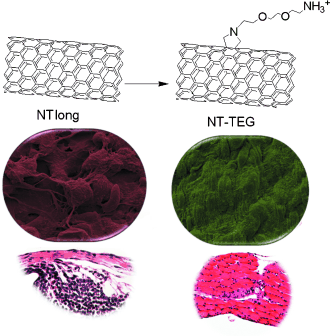Chemistry resolves toxic concerns about carbon nanotubes

Safety fears about carbon nanotubes, due to their structural similarity to asbestos, have been alleviated following research showing that reducing their length removes their toxic properties.
In a new study, published today in the journal Angewandte Chemie, evidence is provided that the asbestos-like reactivity and pathogenicity reported for long, pristine nanotubes can be completely alleviated if their surface is modified and their effective length is reduced as a result of chemical treatment.
First atomically described in the 1990s, carbon nanotubes are sheets of carbon atoms rolled up into hollow tubes just a few nanometres in diameter. Engineered carbon nanotubes can be chemically modified, with the addition of chemotherapeutic drugs, fluorescent tags or nucleic acids – opening up applications in cancer and gene therapy.
Furthermore, these chemically modified carbon nanotubes can pierce the cell membrane, acting as a kind of 'nano-needle', allowing the possibility of efficient transport of therapeutic and diagnostic agents directly into the cytoplasm of cells.
Among their downsides however, have been concerns about their safety profile. One of the most serious concerns, highlighted in 2008, involves the carcinogenic risk from the exposure and persistence of such fibres in the body. Some studies indicate that when long untreated carbon nanotubes are injected to the abdominal cavity of mice they can induce unwanted responses resembling those associated with exposure to certain asbestos fibres.
In this paper, the authors describe two different reactions which ask if any chemical modification can render the nanotubes non-toxic. They conclude that not all chemical treatments alleviate the toxicity risks associated with the material. Only those reactions that are able to render carbon nanotubes short and stably suspended in biological fluids without aggregation are able to result in safe, risk-free material.
Professor Kostas Kostarelos, Chair of Nanomedicine at the UCL School of Pharmacy who led the research with his long term collaborators Doctor Alberto Bianco of the CNRS in Strasbourg, France and Professor Maurizio Prato of the University of Trieste, Italy, said: "The apparent structural similarity between carbon nanotubes and asbestos fibres has generated serious concerns about their safety profile and has resulted in many unreasonable proposals of a halt in the use of these materials even in well-controlled and strictly regulated applications, such as biomedical ones. What we show for the first time is that in order to design risk-free carbon nanotubes both chemical treatment and shortening are needed."
He added: "Creative strategies to identify the characteristics that nanoparticles should possess in order to be rendered 'safe-for-use', and the ways to achieve that, are essential as nanotechnology and its tools are maturing into applications and becoming part of our everyday lives."
More information: 'Asbestos-like pathogenicity of long carbon nanotubes alleviated by chemical functionalization' is published in the journal Angewandte Chemie on 15 January. onlinelibrary.wiley.com/doi/10 … e.201207664/abstract
Journal information: Angewandte Chemie
Provided by University College London















